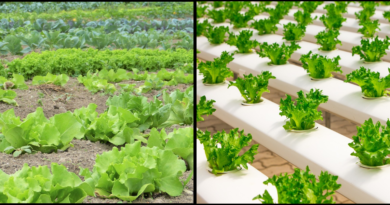Dynamic Agriculture and Its Top 15 Examples

Introduction:
New approaches are necessary in the dynamic field of agriculture to minimize environmental effects and satisfy the expanding needs of the world’s population. Dynamic agriculture is one such cutting-edge idea that is becoming more and more popular. Modern farming optimizes crop yields, preserves resources, and fosters ecological balance via the use of technology, sustainable practices, and data-driven decision-making.
What is dynamic agriculture?
Dynamic agriculture represents a paradigm shift in traditional farming methods. A highly effective and responsive agricultural system is created by integrating cutting-edge technology like artificial intelligence, robots, data analytics, and the Internet of Things (IoT). The fundamental idea is to modify agricultural techniques in real time in response to crop health, environmental factors, and resource availability. Automation, including the use of robotics, is also a key feature of dynamic agriculture.
Top 15 Examples of Dynamic Agriculture:
Precision Farming:
Utilizing sensors, data analytics, and GPS technology, precision farminghttps://en.wikipedia.org/wiki/Precision_agriculture aims to accurately control field variability. Utilizing insecticides, fertilizers, and water more efficiently may boost productivity and lessen environmental effects for farmers.
Vertical Farming:
By growing crops in layers stacked vertically, vertical farming makes the most of the available space.https://en.wikipedia.org/wiki/Vertical_farming Water conservation throughout the year is ensured by controlled facilities with artificial lighting, temperature control, and fertilizer delivery systems.
Drones in Agriculture:

Precision spraying, pest management, and agricultural monitoring are all accomplished with drones that are fitted with cameras and sensors. Thanks to this technology, farmers can make quick, well-informed decisions since they have access to real-time data.
Smart Greenhouses:
Automation and sensors are used by smart greenhouses to produce the perfect atmosphere for plant development. Increased yields are the consequence of providing crops with ideal circumstances through automated temperature control, irrigation systems, and fertilizer delivery.
Aquaponics:
A symbiotic system known as aquaponics blends hydroponics (soil-less plant growing) and aquaculture (fish farming). Fish tank water is rich in nutrients, and plants use this natural fertilizer to grow and clean the water for the fish.
IoT-Enabled Agriculture:
Across the farm, the Internet of Things (IoT) links sensors and equipment to provide real-time information on crop status, weather, and soil health. This connectivity improves overall farm management by enabling data-driven decision-making.
Robotic Farming:
Planting, harvesting, and weeding are just a few of the jobs that autonomous robots with AI and machine learning algorithms can accomplish.Sustainable Agriculture through Robotics and Automation Robotic farming lessens the need for chemical inputs, boosts productivity, and lowers labor expenses.
Biological Pest Control:
The focus of dynamic agriculture is on sustainable and all-natural pest management techniques. To control insect populations without resorting to chemical pesticides, biological pest management techniques include introducing natural predators or employing helpful microbes.
Blockchain in Agriculture:
The agricultural supply chain benefits from increased traceability and transparency thanks to blockchain technology. Every step of manufacturing and delivery, from seed to table, is tracked, guaranteeing the legitimacy of organic goods and fair trade methods.
Soil Health Monitoring:
Farmers may evaluate the nutrient levels, moisture content, and general condition of their soil by using sophisticated sensors to continuously monitor the health of the soil. Precise irrigation and fertilization plans are made possible by this information, which supports long-term soil management.
Variable Rate Technology (VRT):
By using VRT, inputs like herbicides, fertilizer, and seed may be adjusted to meet the unique requirements of various fields’ sections. This precision farming method reduces its negative effects on the environment while optimizing resource consumption.
Farm Management Software:
utilizing cutting-edge farm management software that combines information from several sources, like sensors, meteorological predictions, and market trends. With the use of this software, farmers can plan and operate their farms more efficiently by making well-informed decisions.
Hydroponics:
making use of hydroponic systems, which do not require soil and instead supply nutrient-rich water straight to plant roots. Plant development is accelerated by this soilless cultivation technique, which also optimizes water efficiency and nutrient absorption.
Climate-Responsive Crops:
creating and raising crops that have undergone genetic modification to flourish in certain environmental circumstances. By improving resistance to climate change, these climate-responsive crops guarantee steady yields even in the face of changing weather patterns.
Organic Farming Technologies:
applying cutting-edge technology to crop rotation, cover crops, and the use of natural fertilizers in organic agricultural techniques. Sustainable agriculture How Sustainable Practices Can Extend Your Life is aided by this fusion of contemporary technology and conventional organic farming practices.
conclusion
This variety of dynamic agriculture examples highlights the approach’s multidimensional character. The future of farming will be shaped by dynamic agriculture, which combines data-driven strategies, sustainable practices, and technology innovation. This will lead to increased farming efficiency, adaptability, and ecological responsibility.





Pingback: Drones for Sustainable farming: Modern practices.......